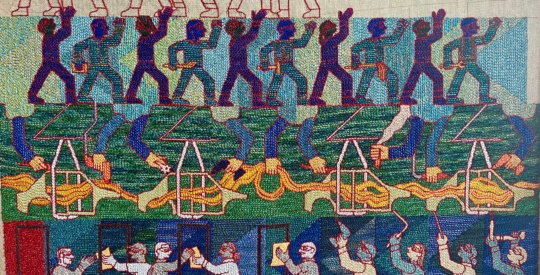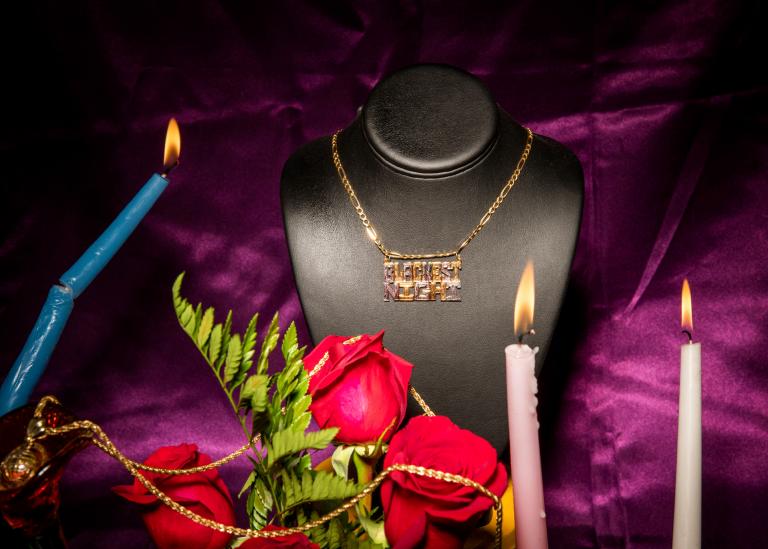
Somewhere within every citizen’s mind resides a familiar affinity with their country’s important cities. Especially today, someone who has never been to New York or London or Paris still possesses an impression of those cities in their mind, as unshakeable as the weather. Artist Azikiwe Mohammed’s speculative city New Davonhaime further experiments with our understanding of pervasive urban aesthetics through the kaleidoscopic lens of Black American life. The environment for Mohammed’s ongoing project Jimmy’s Thrift, New Davonhaime incorporates elements of Black cultural capitals and touchstones into a cohesive, uncannily familiar landscape. In Blackest Night: A Survey in Blackness, his first museum solo exhibition, the New York-based artist brings airbrushed t-shirts, gold chains, and porcelain plates bearing an array of Gucci Mane mugshots to the SCAD Museum of Art in Savannah. It’s a family reunion in a museum — you can almost hear “Before I Let Go” playing. Through photographs, paintings, installations, and performances, Azikiwe Mohammed reminds us that it doesn’t matter if you’ve never been to Atlanta or Harlem or Detroit, because Black people built it, colored it, abandoned it, burned it—their memories are our memories, and New Davonhaime is everywhere.
Our conversation was conducted via email in March and April and has been edited for publication.

Jasmine Amussen: The place where Jimmy’s Thrift is located is an amalgamation of several American cities. Can you tell me about how you chose elements from each place to make this imagined Black city? What was important for you to include? Black people give cities such distinct personalities—I’m surprised I can’t say Jimmy’s Thrift is definitely in Atlanta.
Azikiwe Mohammed: As Black people we have always had to speak in codified language in the interest of safety, from the days of slavery to more modern times, as in cases of code switching in the workplace. This language often turns into cultural trends. As one portion gets taken and Post Malone’d, we make more—always have, always will. This constant need to rebuild and remake what has been taken from Black culture and bastardized makes for a language that, while seasoned by regional differences, is relatively universal and includes visual iterations as well as sonic forms. Due to this fluidity, I don’t need to outline which parts of which place come from where, but the visitors to Jimmy’s Thrift are able to throw their jacket onto the couch I have provided. The couch I have provided is called New Davonhaime, and the cities that make up New Davonhaime are New Orleans, Savannah, Jackson, Birmingham, and Detroit. These are some of the cities in America with the highest population density of Black people as determined by years of census data.
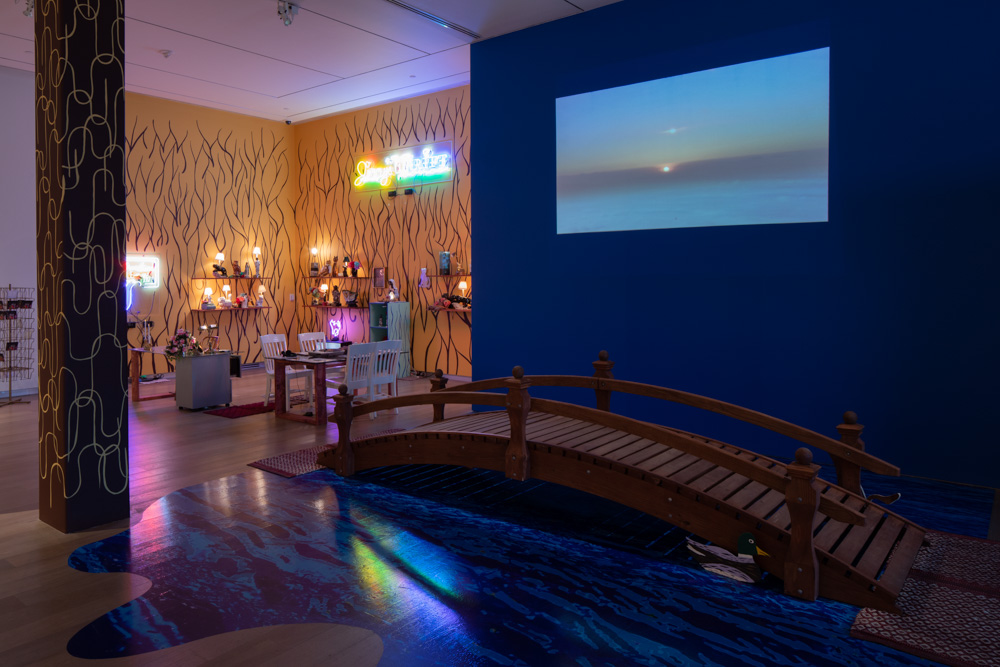
JA: In addition to your solo show in Savannah, you recently got back from installing in Wisconsin. Tell me about the work you currently have on view at the Kohler Arts Center.
AM: That exhibition is a group show called The Autotopographers, which is based on an idea set forth by art historian Jennifer A. Gonzalez arguing that “aspects of biography can be revealed in the creation of one’s environment.” My offering for the show is a version of T.T. Davis Park, the first public space for New Davonhaime—its name is derived from the names of Harriet Tubman, Nat Turner, and Angela Davis. T.T. Davis Park is an attempt to look at public space in Brown communities, or the lack of it, to examine what it would look like if it were realized. My installation offers words and views from potential visitors to the park, as well as descriptions of the surrounding landscape in the form of audio pieces and bins of photographs that have descriptions of each image affixed to the backs of the prints.
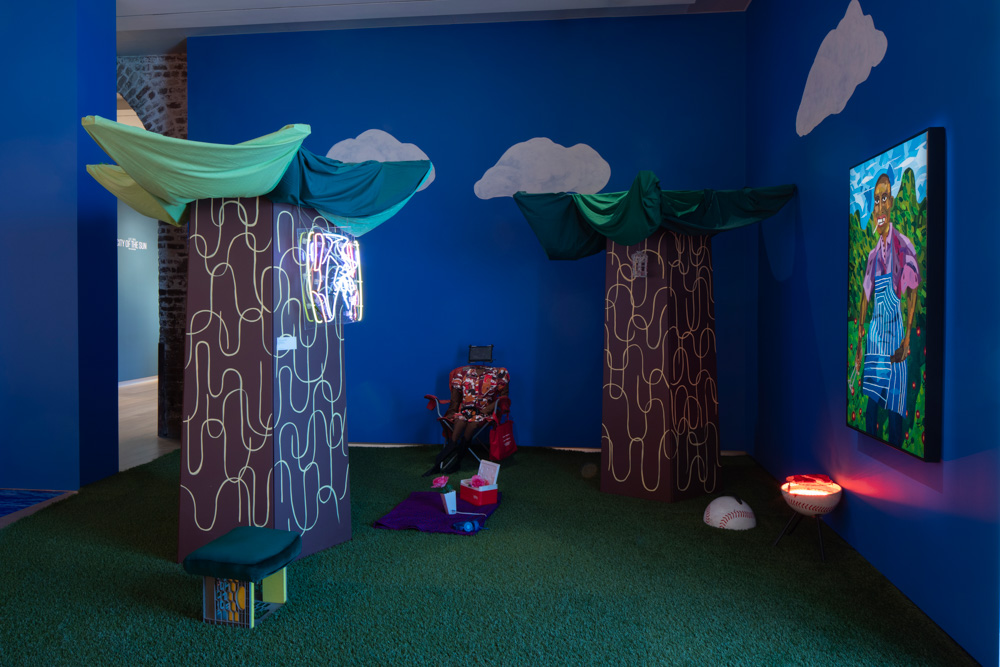

JA: I found your journal imagery very delicate, almost wistful, suffused with longing—even beyond being shot on 35mm film. How does your personal work influence your professional work, or do you strive to keep the two worlds separate?
AM: At this point most of my personal work is my professional work, and I keep my road journal as a tool to remember all of the places I’ve visited, hotels I’ve stayed at, and locations of the photographs I took so that I could re-shoot anything without needing to remember all of the details. This frees my mind to focus on the work ahead of me. I shoot 35mm because I think it looks better, and also, pragmatically, I print most of my own photographs in the darkroom, so it’s easier for me that way. There is no need to long for an event that has already happened, but it is always good to remember so you can improve in the future.
JA: There is a lot of handwringing going on right now about digital cameras ruining our memories. Sally Mann, who is frequently criticized for taking pictures of a South that exists only in the white imagination, has also described using her camera in a similar fashion—as sort of an extension, an addition, but not a replacement of memory.
Memory is such an important facet of showing love and preserving treasure, and the Black memory is long, especially in the South, and especially in the places you modeled New Davonhaime around. It’s also a huge part of mythmaking—at the bottom of every legend is a kernel of truth, a true memory. Is there a way to look at your work as an additional tool for memory—the memory of Black spaces (or Blackness), real or unreal? What myth you are making?
AM: I am thirty-five years old. I remember the internet not existing, the painful patience of dial-up and the first out-of-focus, banal photos a friend sent me with their < 1mp camera phone. We still used point-and-shoot film cameras. Most of those times I remember well, and it’s not that they weren’t documented as feverishly as we do now with our camera phones, largely for social media—but they were documented differently, with limits. You had twenty-four or thirty-six shots, and the ones that would now be deleted from your phone were still handled by the photo lab person, and they always resulted in a pile of prints.

As the years tick on, the images that seemed to be of less importance at the time have grown into the only ones I care about. That chance to allow time to curate your memories—not curating in the moment—is the main sea change we currently swim in. Memory grows as new experiences are added to either side of the mental memory scrapbook we keep in our minds, but if we only allow space for one page and constantly replace everything on that one page with something better, we lose context, and context is what turns memories into stories, and stories into fables. Fables are how we pass down history.
This is why many people my age and younger have added the point-and-shoot camera back to their visual vocabulary, why Polaroid is being sold at Walmart and Target. We may purchase these cameras as an attempt to swim upstream, but in most cases there is still something missing. Neither of these stores sells rolls of film. Rolls of film go into cameras that are intentionality makers. Disposable film cameras require no commitment to the item and are usually turned into a CD of scans. The disposable camera acts as an in-person photo filter, not a return to intentionality. We are made to pay for intentionality. Nowhere is this better seen than in the over-inflated cost of almost any point-and-shoot reloadable film camera. As has always has been the case, longevity is saved for those who can afford it, an extension of the expense of time, the most expensive of humankind’s resources. This is where the creation of the white imagination stems from: an excess of time, an excess of resources, and oftentimes the cash to back both.
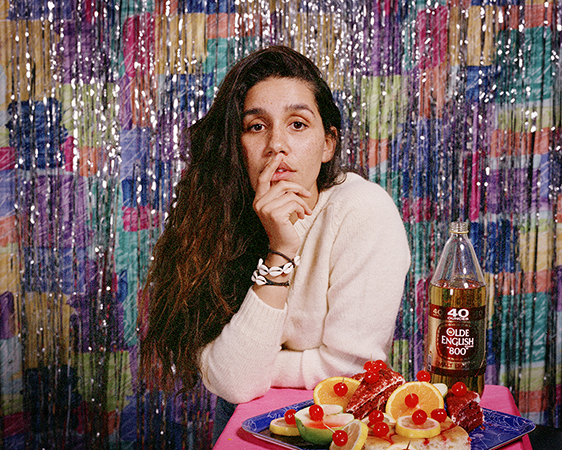
This is where my series Black Internet grew from. I wanted to see if the ideas and visual practices of the white imagination would still hold their form when applied to Black people. What is it that makes our language so malleable and the white imagination so monolithic? With my photographic work, I look to provide information that can be added to the left or right pages of someone’s mental memory scrapbook, in hopes that a story will grow and that a fable of years past may get a new haircut. I don’t want to make any myths, that’s not my job. My job is to handshake the memories already created by our people, introduce as much intentionality as possible into all of these handshakes, and then hand them out to anyone interested in adding a page to their scrapbooks.
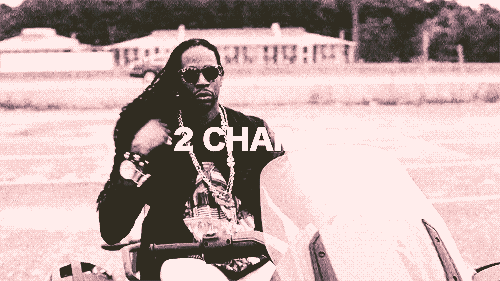
2 Chainz as an example of soft ghetto aesthetics, courtesy Tumblr.
JA: Your series Black Internet reminds me a little bit of soft ghetto and other sort of Black-on-the-internet aesthetics that were a little absurd, a little sexy, a little hardcore, and very meticulous and consistent. Soft ghetto and those other sort of Tumblr aesthetics don’t really exist anymore, and Black Twitter is more and more appropriated every day. Where do you see the Black internet living now, or in the future?
AM: I was not familiar with soft ghetto until just now, and thank you. The aesthetic is quite wavy. I think a lot of these parallel visions of and alternatives to mainstream Blackness exist because celebrating the wide landscape Blackness grows across is a task only accomplishable somewhere with enough space, and one of those places is the internet. Tumblr was a great tool for many of us with these similar aesthetics to find each other, but as the wider definitions of Blackness have become more mainstream or socially accepted, the role of these online spaces hasn’t diminished but has shifted. What first existed as an internet aesthetic now lives in the real world as the line between both spaces continues to blur, and I hope this only continues further as time goes on. As for Black Twitter, whenever they take something from that complicated and magical space, we gone make up some next, so I’m not worried about anything over there. We always gone be fine.
Azikiwe Mohammed’s solo exhibition Blackest Night: A Survey in Blackness is on view at the SCAD Museum of Art in Savannah, Georgia, through September 1.



